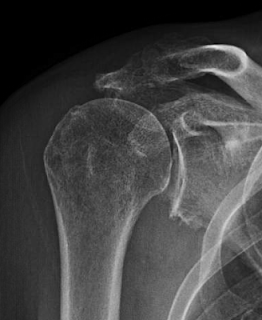This article again shows the relentless dedication of the senior author to improving the art of reverse total shoulder.
The topic of glenoid base plate fixation is of interest in that in the reverse total shoulder much greater loads are applied to this fixation that with anatomic total shoulders.
In a prior article we have suggested that optimizing contact between the baseplate and the bone enhances resistance to component loosening. The topic of fixation has also been addressed in a previous post.
There is another risk with the third approach listed above - reaming through the thin subchondral bone of the glenoid typical of folks needing a reverse total shoulder. Reaming through this thin layer of bone places the baseplate on softer cancellous bone, making failure more likely. Our practice is to minimize reaming, never using power, just to the point where the baseplate will be completely supported. Furthermore, we do not seek to angle the glenoid prosthesis inferiorly in that this also requires compromising the thin subchondral bone as shown in a gentleman from Los Angeles for whom we did a reverse last week.
In this article the authors examined the hypothesis that increases in implant-bone contact improves stability through load sharing with respect to baseplate fixation. This hypothesis was tested in 3-dimensional models in which total implant-bone contact area was compared for two conditions: (1) baseplate flush with bone and no additional glenosphere contact, or (2) baseplate and glenosphere undersurface in contact with bone. Micromotion and stress were computed for each size of implant in the two conditions. They found that increased total contact area when the glenosphere is in contact with bone reduced stress and micromotion.
Achieving glenosphere contact with bone can be achieved in at least three ways (1) designing the implant so that the glenosphere is flush with the baseplate, (2) using bone graft to make up the gap between the medial aspect of the glenosphere and the bone and (3) and reaming the glenoid so that the baseplate is inset, allowing the glenosphere to contact the bone.
As is pointed out in this article, each of these approaches carries the risk of incomplete seating of the glenosphere on the baseplate giving rise to the risk of dissociation of the glenosphere. Assuring complete seating of the glenosphere is a key part of this surgery. We surely don't want the Anne Boleyn syndrome where the head is separated from the body!
There is another risk with the third approach listed above - reaming through the thin subchondral bone of the glenoid typical of folks needing a reverse total shoulder. Reaming through this thin layer of bone places the baseplate on softer cancellous bone, making failure more likely. Our practice is to minimize reaming, never using power, just to the point where the baseplate will be completely supported. Furthermore, we do not seek to angle the glenoid prosthesis inferiorly in that this also requires compromising the thin subchondral bone as shown in a gentleman from Los Angeles for whom we did a reverse last week.
In the post operative film, note that the subchondral plate is still present.
===
Use the "Search" box to the right to find other topics of interest to you.
You may be interested in some of our most visited web pages including:shoulder arthritis, total shoulder, ream and run, reverse total shoulder, CTA arthroplasty, and rotator cuff surgery.
You may be interested in some of our most visited web pages including:shoulder arthritis, total shoulder, ream and run, reverse total shoulder, CTA arthroplasty, and rotator cuff surgery.


